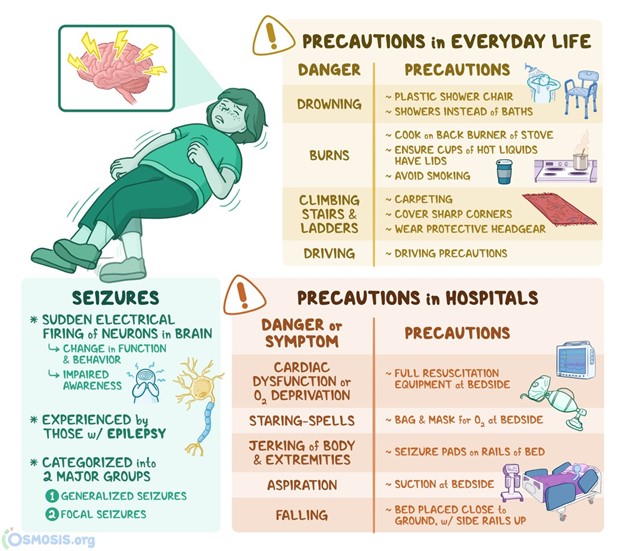A charge nurse is teaching new staff members about factors that increase a client’s risk to become violent.
Which of the following risk factors should the nurse include as the best predictor of future violence?
A history of being in prison.
Previous violent behavior.
Experiencing delusions.
Male gender.
The Correct Answer is B
The correct answer is B.
Previous violent behavior. According to the web search results, this is the best predictor of future violence among the given risk factors.
Other risk factors include past history of aggression, poor impulse control, and violence. Comorbidity that leads to acts of violence (psychotic delusions, command hallucinations, violent angry reactions with cognitive disorders).
Choice A is wrong because a history of being in prison is not a direct cause of violence, but rather a possible consequence of it.
Choice C is wrong because male gender is not a sufficient factor to predict violence, as there are many other variables involved. Choice D is wrong because experiencing delusions is not necessarily associated with violence, unless they are of a paranoid or persecutory nature.
Normal ranges for violence risk assessment are not standardized, but some tools that can be used include the Historical Clinical Risk Management-20 (HCR-20), the Violence Risk Appraisal Guide (VRAG), and the Psychopathy Checklist-Revised (PCL-R). These tools use different scales and criteria to evaluate the likelihood of violent behavior in individuals.
Nursing Test Bank
Naxlex Comprehensive Predictor Exams
Related Questions
Correct Answer is B
Explanation
The correct answer is choice B. Fish. Fish is a good source of protein and omega-3 fatty acids, which can help lower blood pressure, reduce inflammation, and prevent blood clots. Fish is also low in sodium, which is important for people with hypertension, as excess sodium can raise blood pressure by retaining fluid in the body. Fish is part of the DASH diet, which stands for Dietary Approaches to Stop Hypertension, and is a healthy eating plan that emphasizes fruits, vegetables, whole grains, low-fat dairy, nuts, seeds, legumes, and lean meats.
Choice A. Cheese is wrong because cheese is high in sodium and saturated fat, which can increase blood pressure and cholesterol levels.
Cheese should be limited or avoided by people with hypertension.
Choice C. Red meat is wrong because red meat is also high in sodium and saturated fat, as well as cholesterol, which can contribute to hypertension and heart disease.
Red meat should be eaten sparingly or replaced by leaner sources of protein like fish, poultry, or beans.
Choice D. Canned black beans are wrong because canned black beans are high in sodium, as most canned foods are preserved with salt. Canned black beans should be rinsed well before eating or replaced by dried or cooked black beans, which are lower in sodium and high in fiber, potassium, magnesium, and calcium, which are beneficial for blood pressure control.
Correct Answer is C
Explanation

Hyperthermia is a condition in which the body temperature is abnormally high, usually due to exposure to heat, infection, or certain medications.
Hyperthermia can cause neurological complications, such as seizures, confusion, or coma. Therefore, the nurse should initiate seizure precautions for an adolescent who has hyperthermia to prevent injury and protect the airway.
Choice A is wrong because covering the adolescent with a thermal blanket would increase the body temperature and worsen hyperthermia. The nurse should remove excess clothing and use cooling measures, such as fans, ice packs, or cool fluids.
Choice B is wrong because submerging the adolescent’s feet in ice water would cause vasoconstriction and shivering, which would reduce heat loss and increase heat production. The nurse should avoid using extreme cold or ice water to cool the body.
Choice D is wrong because administering oral acetaminophen would not be effective for hyperthermia caused by non-infectious factors, such as heat exposure or medications.
Acetaminophen lowers the body temperature by reducing the hypothalamic set point, which is not altered in hyperthermia. Additionally, oral medications may be difficult to swallow or absorb in a hyperthermic patient.
Normal body temperature ranges from 36.5°C to 37.5°C (97.7°F to 99.5°F). Hyperthermia is defined as a body temperature above 38.5°C (101.3°F).
Whether you are a student looking to ace your exams or a practicing nurse seeking to enhance your expertise , our nursing education contents will empower you with the confidence and competence to make a difference in the lives of patients and become a respected leader in the healthcare field.
Visit Naxlex, invest in your future and unlock endless possibilities with our unparalleled nursing education contents today
Report Wrong Answer on the Current Question
Do you disagree with the answer? If yes, what is your expected answer? Explain.
Kindly be descriptive with the issue you are facing.
